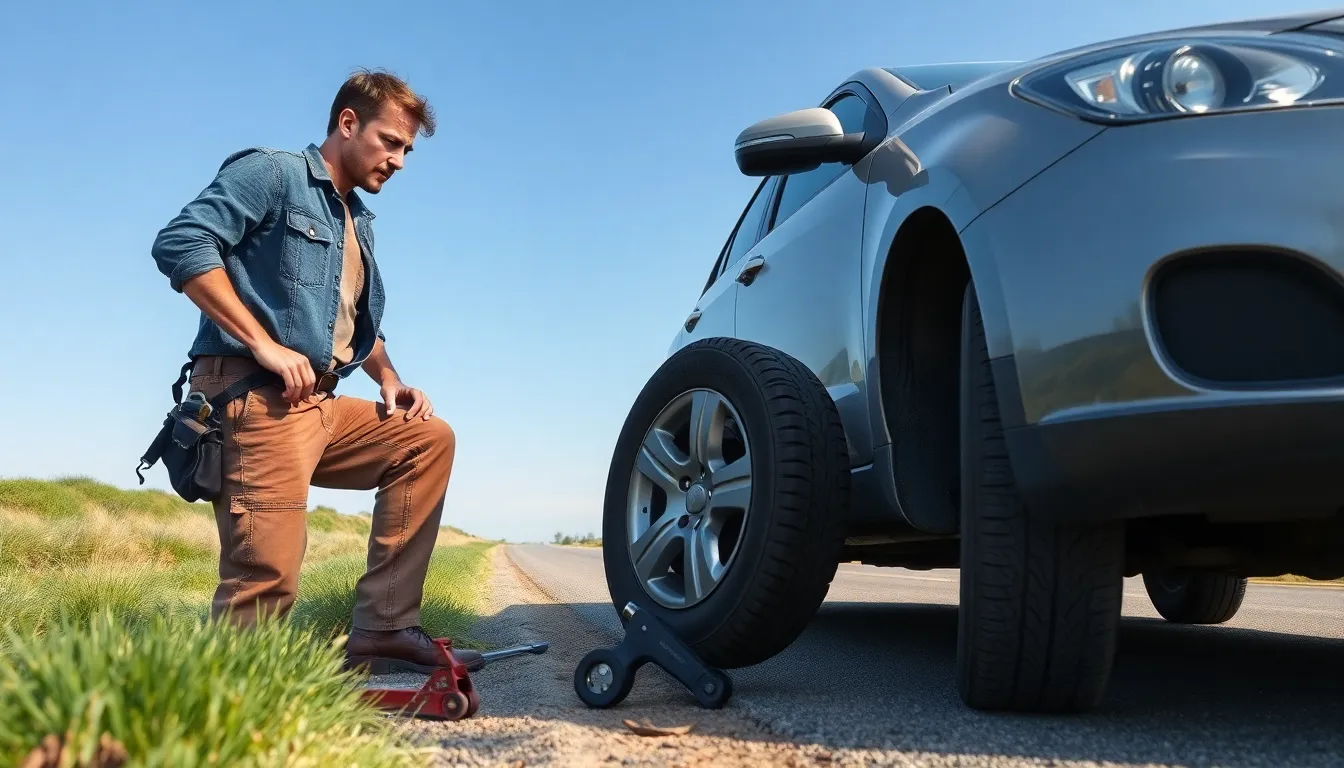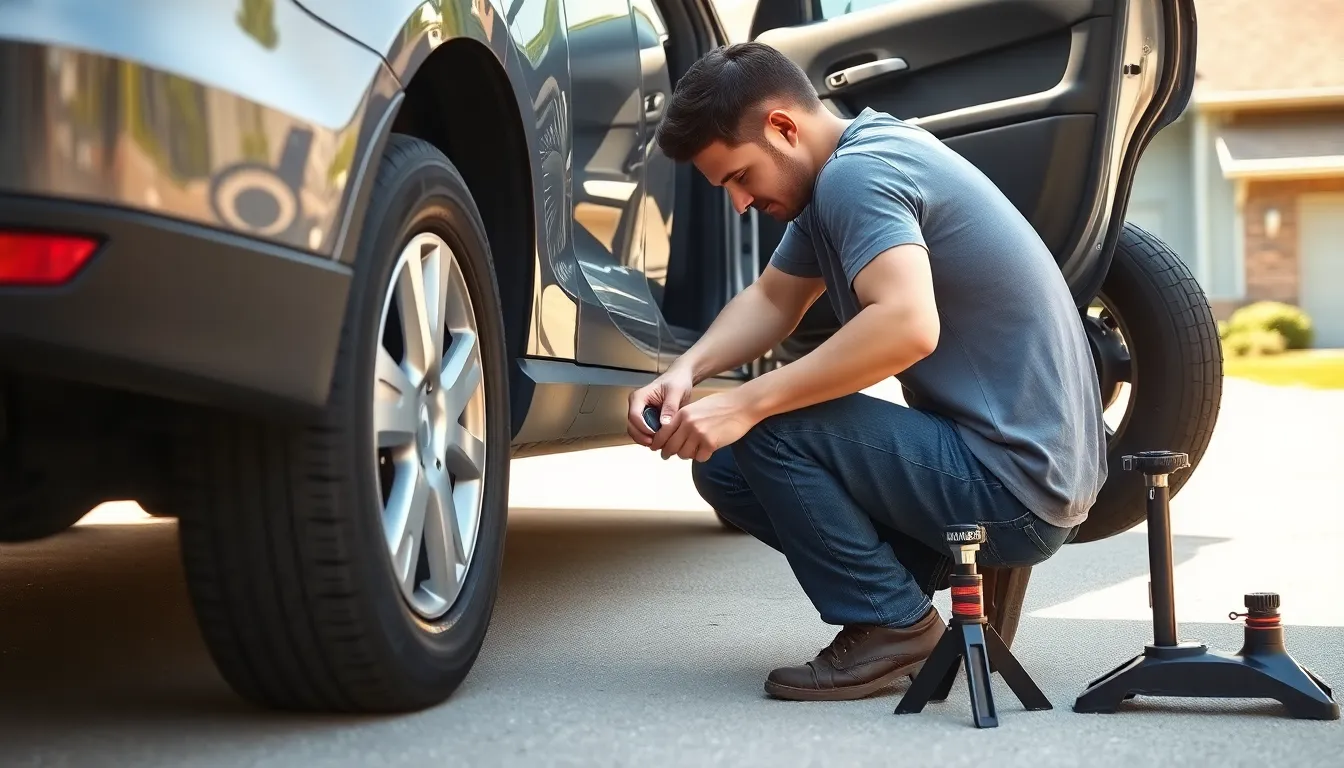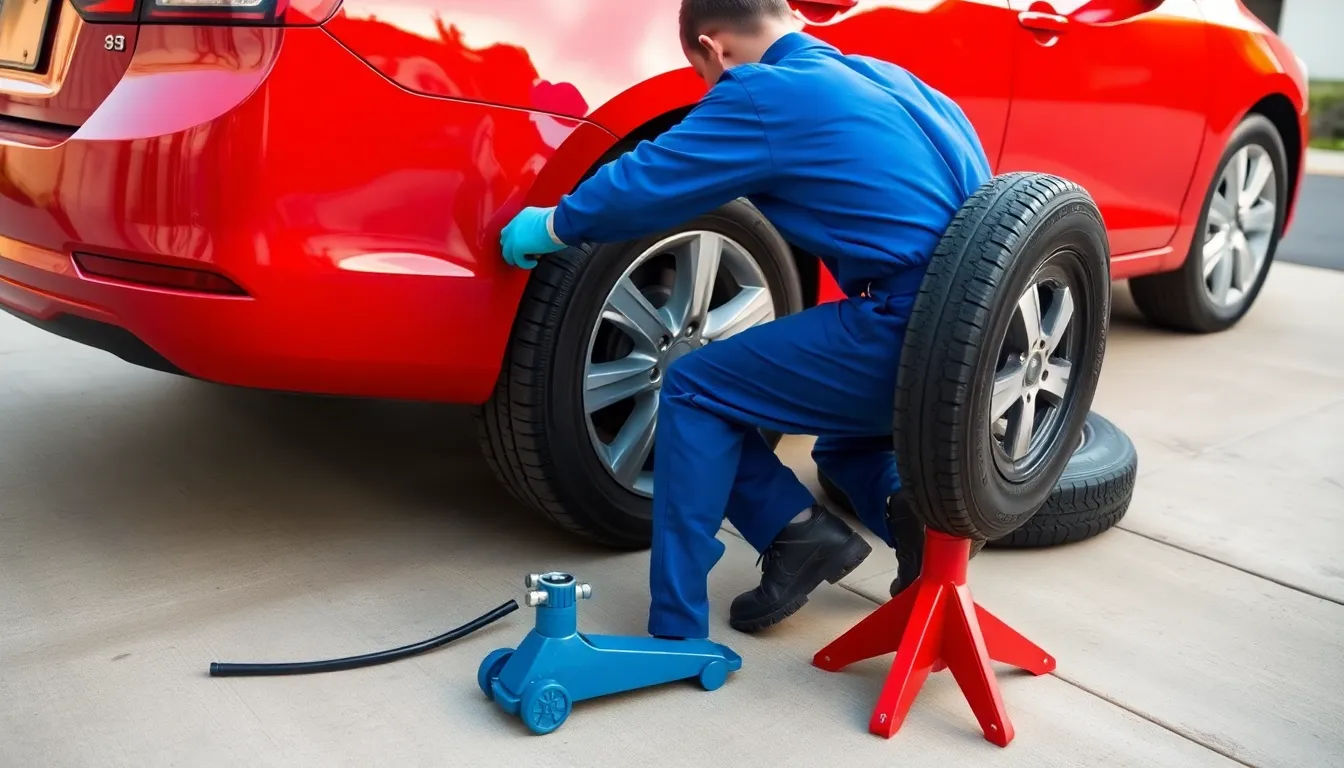Getting stuck with a flat tire can turn your day upside down in seconds. Whether you’re running late for work or miles away from the nearest service station, knowing how quickly you can swap out that damaged tire becomes crucial information that could save your schedule and your sanity.
We’ve all been there – staring at a deflated tire and wondering if we should attempt the change ourselves or call for help. The truth is, changing a tire doesn’t have to be the time-consuming nightmare you might imagine. With the right knowledge and preparation, this essential skill can be mastered faster than you think.
Understanding the typical timeframes for tire changes empowers you to make better decisions when you’re facing this common roadside challenge. From DIY swaps to professional installations, we’ll break down exactly what you can expect and how to minimize your downtime when tire trouble strikes.
How Long Does It Take to Change Tires: The Complete Breakdown
Changing a single tire takes 15-30 minutes for experienced DIYers under normal conditions. Professional tire shops complete the same task in 10-15 minutes per tire using specialized equipment and streamlined processes.
Factors That Affect Tire Changing Speed
Several variables influence how quickly you can swap out your tires. Weather conditions significantly impact completion time, with rain or snow adding 5-10 minutes to the process. Vehicle type plays a crucial role, as compact cars allow easier access than large trucks or SUVs.
Experience level determines efficiency more than any other factor. First-time tire changers often require 45-60 minutes for a single tire, while seasoned mechanics complete the task in under 10 minutes. Available tools affect speed dramatically, with proper equipment reducing time by 50% compared to basic roadside kits.
Professional vs DIY Tire Changing Times
| Service Type | Time Per Tire | Complete Set | Additional Services |
|---|---|---|---|
| Professional Shop | 10-15 minutes | 45-60 minutes | Balancing, alignment checks |
| Mobile Service | 15-20 minutes | 60-90 minutes | Travel time included |
| DIY Experienced | 15-30 minutes | 60-120 minutes | Basic installation only |
| DIY Beginner | 30-60 minutes | 120-240 minutes | Learning curve factor |
Professional services provide additional benefits beyond speed. Technicians inspect wheel alignment, check tire pressure and perform safety evaluations during installation. Mobile tire services add convenience but require longer timeframes due to travel logistics.
Tire Changing Time by Vehicle Type
Passenger cars offer the quickest tire changes due to standard lug patterns and accessible jack points. Compact vehicles like Honda Civic or Toyota Corolla typically require 15-20 minutes per tire for DIY changes.
SUVs and trucks present additional challenges that extend changing time. Higher ground clearance requires more pumping with standard jacks, adding 5-10 minutes per tire. Heavy-duty vehicles like Ford F-150 or Chevrolet Silverado often need specialized equipment for safe lifting.
Sports cars with low-profile tires demand extra care during installation. Performance vehicles require precise torque specifications and careful handling to avoid rim damage. Luxury vehicles may have specialized locking lug nuts that add complexity to the process.
Emergency Roadside Tire Changes
Roadside emergencies create unique time constraints that affect changing speed. Limited lighting conditions extend completion time by 15-30 minutes compared to garage installations. Traffic proximity adds safety concerns that require additional caution and slower movements.
Emergency situations often involve damaged or stuck lug nuts that complicate removal. Corroded hardware can double the time required for a single tire change. Weather exposure during roadside changes affects both safety and efficiency, particularly in extreme temperatures.
Preparation reduces emergency tire changing time significantly. Pre-positioned tools and familiarization with your vehicle’s jack points can cut completion time by 25%. Regular tire rotation practice builds muscle memory that proves invaluable during stressful roadside situations.
Factors That Affect Tire Changing Time

Several variables influence how quickly you can complete a tire change. Understanding these factors helps you set realistic expectations and prepare accordingly.
Your Experience Level
Experience dramatically impacts tire changing speed and efficiency. Professionals with extensive practice complete single tire changes in 5 to 15 minutes using proper equipment. Less experienced individuals typically require 15 to 30 minutes for the same task.
First-time changers often encounter unexpected challenges that extend their timeline significantly. Familiarizing yourself with your vehicle’s jack points and tire changing procedures before an emergency reduces completion time. Practice sessions in controlled environments build confidence and muscle memory for actual roadside situations.
Type of Vehicle
Vehicle design and weight affect tire changing complexity and duration. Passenger cars offer easier access to jack points and lighter wheels compared to larger vehicles. SUVs and trucks present additional challenges due to higher ground clearance and heavier tire assemblies.
Professional shops maintain consistent timeframes across vehicle types, completing four tire changes in approximately 45 minutes to an hour regardless of the exact vehicle. Commercial vehicles and specialty cars may require additional time due to unique mounting systems or accessibility constraints.
Tools and Equipment Available
Proper tools significantly reduce tire changing duration and effort. Professional shops equipped with pneumatic tools and hydraulic lifts complete four tire installations in about 40 minutes. Basic hand tools from your vehicle’s emergency kit extend the process but remain sufficient for roadside changes.
Quality equipment improves safety and efficiency during tire changes. Power tools eliminate manual labor associated with lug nut removal and installation. Missing or damaged tools force improvisation that increases completion time and potential safety risks.
Weather and Location Conditions
Environmental factors complicate tire changing procedures and extend completion times. Rain creates slippery surfaces that require extra caution during jack operation and wheel handling. Snow and ice make footing unstable and reduce visibility for nighttime changes.
Location terrain affects stability and safety during tire changes. Soft dirt surfaces require solid jack placement to prevent sinking or shifting. Inclined roads create additional safety concerns and may require wheel chocks to prevent vehicle movement during the process.
Professional vs DIY Tire Changing Times

The choice between professional installation and DIY tire changing significantly impacts both time investment and overall experience. We’ve analyzed service times across different scenarios to help you understand what to expect from each approach.
At a Tire Shop or Service Center
Professional tire technicians complete single tire changes in 15 to 30 minutes depending on current workload and technician expertise. Service centers maintain specialized equipment and standardized procedures that streamline the entire process.
Changing all four tires requires 45 minutes to one hour when professionals handle the installation. This timeframe includes comprehensive services like wheel balancing and alignment checks that extend beyond basic tire mounting. Professional facilities offer additional benefits including safety evaluations and proper disposal of old tires.
Service centers optimize efficiency through hydraulic lifts, pneumatic tools, and organized workflows. Technicians access multiple vehicles simultaneously and coordinate tasks to minimize customer wait times. Most professional installations include warranty coverage and quality guarantees that protect your investment.
Changing Tires Yourself at Home
DIY single tire changes typically require 15 to 30 minutes depending on your experience level and available tools. Home installations often take longer due to manual jack operation and limited workspace compared to professional facilities.
Changing all four tires yourself consumes 1 to 2 hours since the process involves more tires and potentially less experience with proper techniques. Home tire changes require careful attention to safety protocols including proper jack placement and lug nut torque specifications.
DIY installations save money but require investment in quality tools like torque wrenches, jack stands, and tire pressure gauges. Weather conditions significantly impact home tire changing since most people work outdoors without climate controlled environments. Emergency situations add complexity when lighting conditions are poor or road surfaces are unstable.
| Scenario | Professional Time | DIY Time |
|---|---|---|
| Single Tire | 15-30 minutes | 15-30 minutes |
| Four Tires | 45-60 minutes | 1-2 hours |
Step-by-Step Time Estimates for DIY Tire Changes

Breaking down the tire changing process into exact steps reveals exactly where your time goes during a DIY replacement. Each phase requires different skills and presents unique challenges that affect completion speed.
Preparation and Setup
Gathering your tools and establishing safety measures consumes 5 to 10 minutes before you touch the tire. Locating your spare tire, jack, and lug wrench takes roughly 3 minutes if stored properly in your vehicle. Positioning warning triangles or flares adds another 2 minutes to alert other drivers to your presence.
Checking your spare tire’s air pressure prevents discovering a flat backup during installation. Most drivers skip this step and risk extending their roadside time significantly. Setting up your workspace on level ground and captivating the parking brake completes the preparation phase.
Removing the Old Tire
Loosening lug nuts while the tire remains on the ground requires 2 to 5 minutes depending on their tightness. Breaking the initial seal often proves challenging since lug nuts face regular road vibrations that tighten them naturally. Using your body weight on the lug wrench provides the necessary leverage for stubborn nuts.
Raising the vehicle with your jack takes approximately 5 minutes once you locate the proper jacking point. Different vehicles place jack points in various locations, so consulting your owner’s manual saves time and prevents damage. Pumping the jack handle steadily lifts the tire clear of the ground.
Removing the loosened lug nuts and pulling off the flat tire completes this phase in about 5 minutes. Placing the lug nuts in a secure container prevents losing them in grass or rolling surfaces. The total removal process spans 12 to 15 minutes for most standard passenger vehicles.
Installing the New Tire
Aligning the spare tire with the wheel bolts takes 2 to 3 minutes since proper positioning requires careful maneuvering. Lifting the spare onto the hub demands physical strength, especially with full-size tires that weigh 20 to 30 pounds. Temporary spare tires weigh less but require gentle handling due to their lighter construction.
Replacing and hand-tightening the lug nuts consumes roughly 5 minutes to ensure each bolt catches the threads properly. Cross-tightening the nuts in a star pattern distributes pressure evenly across the wheel hub. Avoiding the temptation to fully tighten before lowering prevents wheel wobbling.
Lowering the vehicle back to the ground takes another 5 minutes of careful jack operation. Final tightening of the lug nuts with the tire supporting the vehicle’s weight requires an additional 5 minutes using the star pattern technique. This installation phase totals 17 to 20 minutes when executed methodically.
| Task | Time Required |
|---|---|
| Preparation and Setup | 5-10 minutes |
| Removing Old Tire | 12-15 minutes |
| Installing New Tire | 17-20 minutes |
| Single Tire Total | 15-30 minutes |
| Four Tire Total | 1-2 hours |
Tips to Speed Up Your Tire Changing Process

Speed matters when you’re dealing with a tire change, and having the right approach can cut your time significantly. Professionals complete tire installations in about 40 minutes for four tires, averaging 10 minutes per tire, while individual tire changes take 15-30 minutes depending on preparation and conditions.
Ensure Proper Tools Are Ready
Quality equipment makes the biggest difference in tire changing speed. Use jacks, lug wrenches, and tire irons specifically suited to your vehicle for faster and easier tire removal. Professional grade tools reduce the physical effort required and minimize the risk of stripped bolts or damaged components. Keep your tire changing kit organized in an easily accessible location within your vehicle.
Practice the Process
Familiarize yourself with the steps of loosening lug nuts, lifting the vehicle, changing the tire, and tightening the nuts properly. Regular practice reduces emergency response time from 45-60 minutes for first-time changers to the standard 15-30 minute range. Understanding your vehicle’s jack points and lug nut patterns before you need them prevents costly mistakes and dangerous situations.
Use Professional Services When Possible
Professionals have the experience and equipment to speed up the process, including balancing and alignment services that are critical after tire replacement. Skilled technicians can complete the entire four-tire installation in 30 minutes or less using specialized tools and established workflows. Professional installation also includes safety evaluations and warranty coverage that DIY changes cannot provide.
Prepare the Area
Choose a flat, safe spot with enough space to work efficiently when changing tires yourself. Proper positioning reduces the time spent adjusting your vehicle and prevents safety hazards during the change. Stable ground prevents jack slippage and allows for confident tire removal and installation.
Keep Spare Tires Maintained
Make sure your spare tire is properly inflated and in good condition before you need it. Checking spare tire pressure monthly prevents delays during emergency changes when you discover flat or underinflated backup tires. Replace spare tires that are older than 10 years regardless of tread depth, as aged rubber becomes unreliable and dangerous.
These preparation strategies can reduce your tire changing time from the typical 15-40 minute range to the lower end of professional standards. Weather conditions, vehicle type, and available lighting still affect completion times, but proper preparation minimizes these variables’ impact on your efficiency.
When to Call a Professional Instead

Professional tire changing services become essential when exact circumstances make DIY attempts unsafe or impractical. We recommend seeking professional help when you lack experience with tire changing procedures, as improper installation can lead to dangerous driving conditions and potential accidents.
Complex vehicle situations require professional expertise that goes beyond basic tire changing skills. All-wheel-drive vehicles often need specialized knowledge to prevent drivetrain damage, while luxury cars may require exact torque specifications and handling procedures. Low-profile tires and custom wheels demand careful attention that professionals provide through their training and experience.
Safety concerns make professional services the smart choice in hazardous conditions. Roadside emergencies during heavy traffic, severe weather, or nighttime hours create risks that outweigh the time savings of DIY changes. Professional mobile tire services arrive equipped with proper lighting, safety equipment, and traffic management tools.
Additional services that extend beyond simple tire replacement make professional installation necessary for optimal vehicle performance. Wheel alignment services require specialized equipment that measures precise angles and adjustments. Tire balancing prevents vibration and uneven wear patterns through computerized balancing machines that aren’t available for home use.
Time constraints often make professional services more efficient than DIY attempts. Professional technicians complete tire changes in 15 to 30 minutes due to their experience and proper equipment, while inexperienced individuals may take 45 to 60 minutes or longer. Emergency mobile services reach your location within 30 to 60 minutes, often faster than attempting the change yourself and potentially making mistakes.
Equipment limitations prevent many drivers from performing proper tire changes. Professional shops use pneumatic tools that remove and install lug nuts quickly and with consistent torque specifications. Hydraulic lifts provide safe and stable vehicle elevation compared to portable jacks that may slip or fail on uneven surfaces.
Quality assurance through professional installation includes warranty coverage and safety inspections that DIY changes can’t provide. Professional technicians inspect the wheel assembly, check for damage, and ensure proper installation according to manufacturer specifications.
Conclusion
We’ve explored how tire changing times vary significantly based on experience level vehicle type and circumstances. Whether you’re dealing with an emergency roadside situation or planning a routine tire replacement understanding these timeframes helps you make informed decisions about DIY versus professional services.
The 15-30 minute range for experienced DIYers and 10-15 minutes for professionals gives you realistic expectations for planning your day. Remember that proper preparation quality tools and safe working conditions are essential for efficient tire changes regardless of your experience level.
Eventually choosing between DIY and professional installation depends on your comfort level available time and exact situation. Professional services offer speed expertise and additional safety checks while DIY changes provide cost savings and valuable automotive skills for future emergencies.
Frequently Asked Questions
How long does it typically take to change a tire yourself?
For most DIYers, changing a single tire takes 15-30 minutes. First-time changers may need 45-60 minutes, while experienced individuals can complete it faster. The time includes preparation (5-10 minutes), removing the old tire (12-15 minutes), and installing the new tire (17-20 minutes). Weather conditions, vehicle type, and available tools significantly impact the total time required.
How fast can a professional change a tire?
Professional technicians typically change a single tire in 10-15 minutes, with experienced mechanics completing it in under 10 minutes. Their speed comes from proper equipment, experience, and efficient processes. Professional services also include safety evaluations and alignment checks, which may extend the total service time but provide additional value.
What factors affect tire changing time the most?
Several key factors influence tire changing speed: your experience level, vehicle type and size, available tools and equipment, weather conditions, and location. Passenger cars are quickest to service, while SUVs and trucks take longer due to accessibility challenges. Poor weather, inadequate lighting, or damaged components can significantly extend completion time.
Should I change all four tires at once or one at a time?
Changing all four tires professionally takes 45 minutes to 1 hour, including balancing and alignment. DIY changes for four tires can take 1-2 hours due to safety protocols and less experience. Consider your time constraints, physical capability, and whether additional services like wheel balancing are needed when deciding between single or multiple tire changes.
When should I call a professional instead of changing the tire myself?
Call a professional if you lack experience, have a complex vehicle situation (all-wheel-drive, luxury cars), face hazardous conditions, or need specialized equipment. Professional services provide quality assurance, safety inspections, and additional services like alignment checks that DIY changes cannot guarantee. Emergency situations with poor lighting or damaged components also warrant professional help.
What tools do I need to change a tire quickly?
Essential tools include a spare tire, jack, lug wrench, and wheel chocks. Having these readily available and in good condition significantly reduces changing time. Check your spare tire’s air pressure regularly, ensure your jack functions properly, and consider keeping gloves and a flashlight in your emergency kit for faster, safer tire changes.








